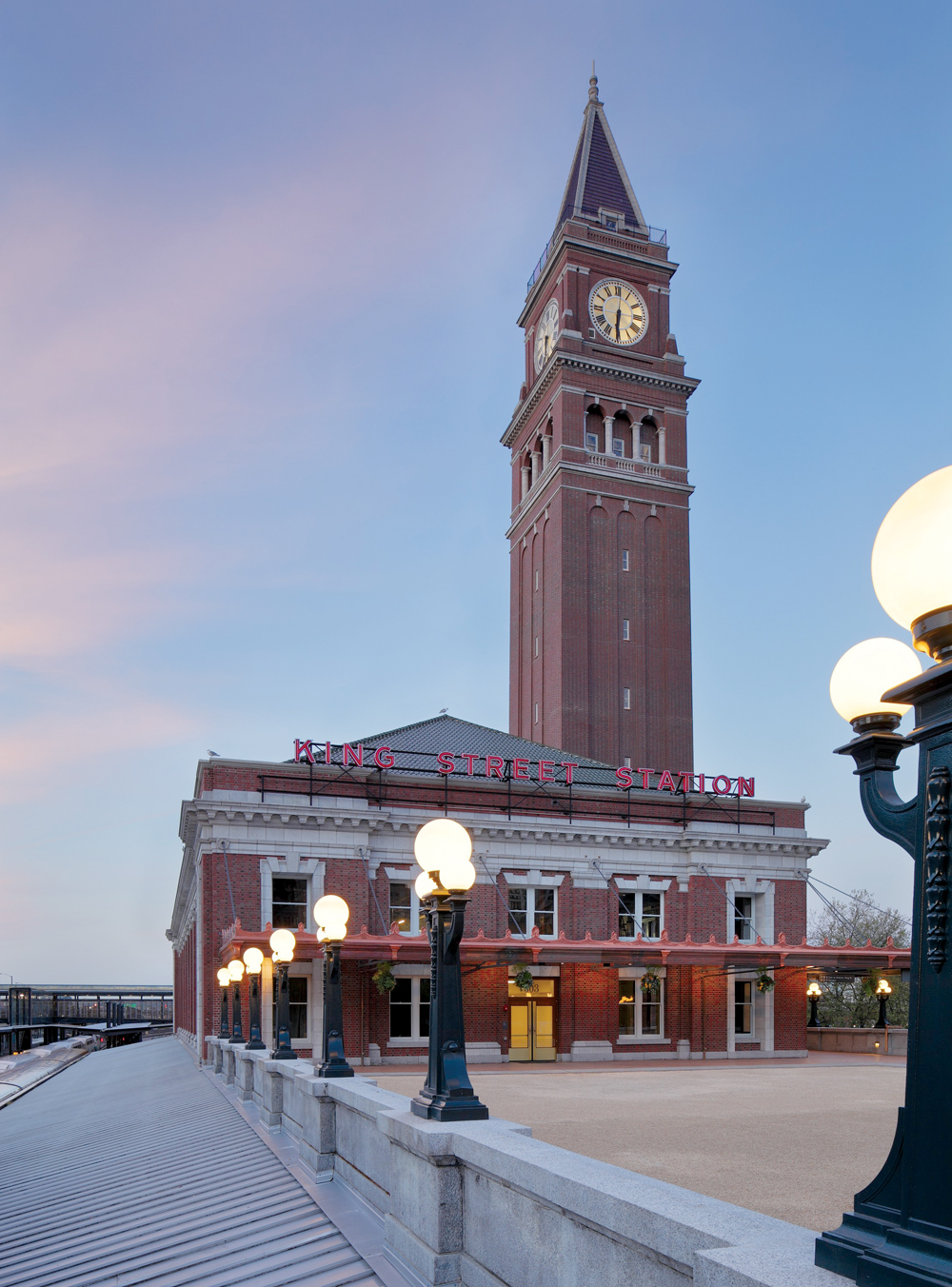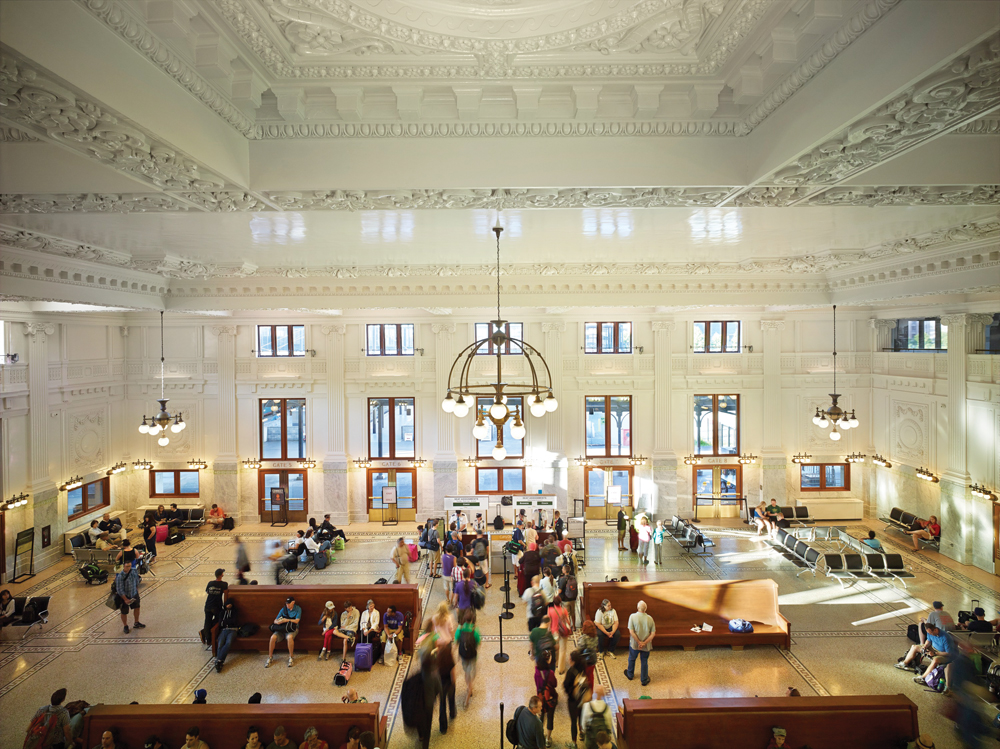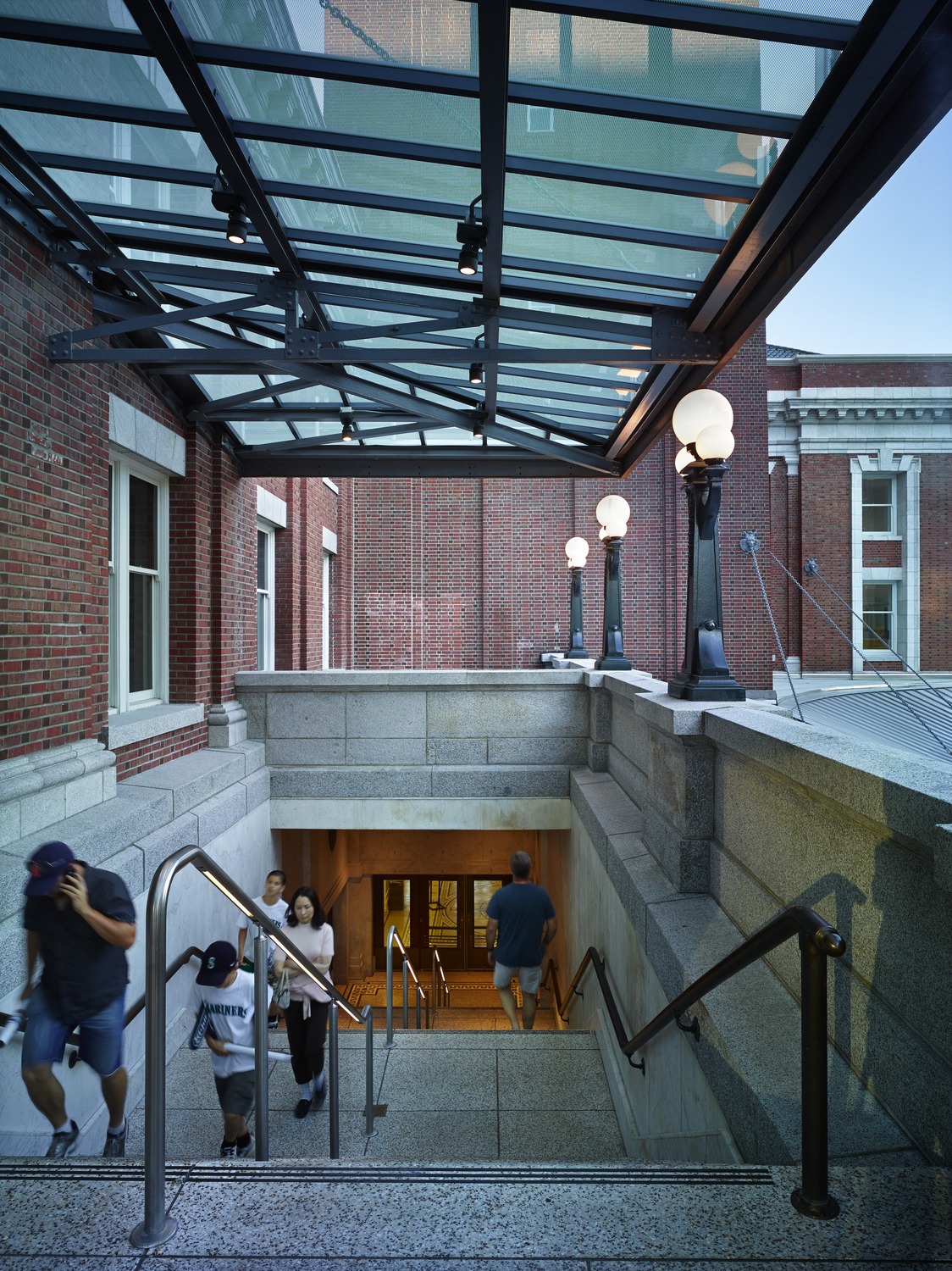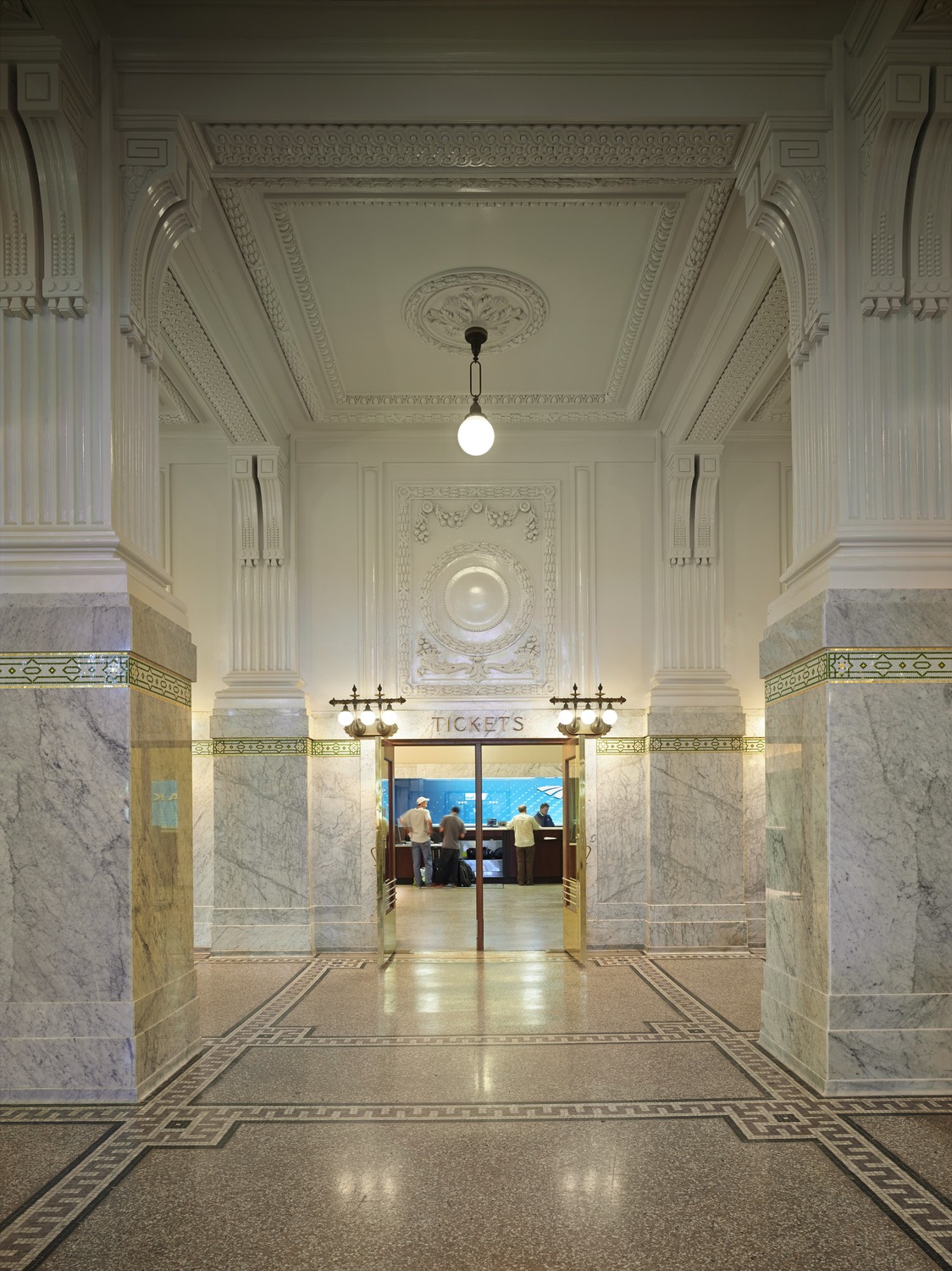When Seattle’s King Street Station opened its doors in 1906, it stood as a bold symbol of the city’s newfound prominence as the region’s primary shipping port—a position the Emerald City holds to this day.
Designed by architects Charles A. Reed (1858-1911) and Allen H. Stem (1856-1931), most noted for their work on New York’s Grand Central Terminal, King Street Station was the centerpiece of a massive enterprise that shifted the city’s main rail lines from the waterfront to the central business district, thanks to the construction of a 5,245-foot tunnel beneath the city. The L-shaped, 62,400-sf terminus quickly became the busiest train station in the Northwest, earning it the nickname “Gateway to the West.”
The Italianate depot features a distinctive, 242-foot-tall clock tower, the second-tallest such structure on the West Coast; it was modeled after the Campanile di San Marco in Venice. At the time of its completion, the station was the tallest structure in Seattle. Inside, bright-white plaster and marble decorated the walls and ceiling of the waiting areas.
The depot was placed on the National Register of Historic Places in 1973, but by that time it had lost much of its grandeur. Poorly conceived modernizations in the ’40s, ’50s, and ’60s led to the removal of large sections of the plaster and marble walls and glass mosaic tile accents. The magnificent plaster ceiling was covered with acoustical tiles. The roof was crumbling. The staircase on Jackson Street was boarded up. The four tower clocks were right only twice a day.
PLATINUM AWARD WINNER
King Street Station
SeattleBuilding Team
Submitting firm: ZGF Architects (architect)
Owner: Seattle Department of Transportation
Structural/MEP engineer: Arup
Construction manager: Shiels Obletz Johnsen
General contractor: Sellen ConstructionGeneral Information
Construction time: Sept. 2009 to April 2013
Size: 62,400 sf
Delivery method: CM at risk
Cost: $55 million
The demise of train travel in the mid-20th century, coupled with a falloff in funding for maintenance, saw the station fall even further into a state of disrepair. Most urgently in need of shoring up were the unreinforced masonry walls—inspections showed that the structure was in no shape to withstand a major seismic event.
As rail ridership began to pick up in the 2000s, the city of Seattle decided it was time to upgrade and restore its landmark rail station. In February 2008, the city purchased the building from the Burlington Northern Railway Company for $10 and then went about rounding up the $55 million needed for a complete rehab and modernization (60% of funding came from federal sources; the balance was split between state and local sources).
The project scope encompassed full seismic retrofit and structural upgrade work, rehabilitation of the clock tower, full MEP/FP upgrades, and repair and restoration of the 45-foot-high ornamental plaster ceilings and walls, the terrazzo and mosaic tile floors, and the operable windows—all while striving for LEED Platinum certification. Complicating matters was a requirement from the city that the station remain fully operational during the project—a goal the team achieved by dividing the work into multiple phases.
INSERTING A NEW STRUCTURE
Half the budget was allocated for the structural repair and seismic retrofit work—a tedious, meticulous process that involved inserting a new steel frame structure inside the existing masonry walls with surgical precision so as not to disturb the historical elements. The Building Team cut 35-foot-high slots into the brick perimeter and inserted steel columns and high-strength grout alongside the existing columns.
New shear walls were created for the 8,000-sf waiting room. Steel floor plates were added on levels two and three for additional strengthening. The 12-story clock tower was cross-braced; new columns were added on all four corners. A total 1,345 tons of steel was installed to support the interior spaces.

A system of geothermal wells was bored underneath the downtown plaza; it is designed to cover 100% of the 62,400-sf building’s heating and cooling needs. The clock tower rises 242 feet to its peak. ZGF Architects led the Building Team for the client, the Seattle Department of Transportation. Photo: Benjamin Benschneider Photography
While not as costly as the structural work, the rehabilitation of the historic interior elements was no less difficult. To replicate damaged and missing elements of the ornamental plaster walls and ceiling, matching molds were painstakingly created using the original ornate pieces and the same casting methods craftsmen employed more than a century ago. The molds were filled with casting plaster and inlaid with hemp and burlap during the casting process to create the final pieces. The castings were then stripped out of the molds, reinstalled, and attached to the structure.
The Building Team removed all of the sashes and trims from the original windows and refinished and reinstalled them using all remaining original glass. In all, the team restored 74 window openings and 199 sashes and replicated 15 window openings and 33 new sashes.
Significant care was taken to protect the floors during the structural steel installation and helical pile drilling. Areas of the marble inlaid terrazzo floors were catalogued, removed, and reinstalled after the new buried structure was installed. Where the original tile flooring was missing, the team repurposed existing pieces of marble to replicate the floor elements.
In honoring King Street Station with a Platinum Award, the Reconstruction Awards jury commended the Building Team on its technical precision in executing both heavy construction work—structural steel reinforcing and geothermal installation—and extremely delicate and often tedious historic restoration work—all while the station remained operational.
“The fact that they were able to execute all of this work while achieving LEED Platinum certification through features like geothermal makes the project even more impressive,” said judge Krista Gnatt, LEED AP, Preconstruction and Business Development Manager with Bulley & Andrews, Chicago.
Related Stories
| Aug 11, 2010
National Association of Governors adopts AIA policy of reaching carbon neutrality in buildings by 2030
As part of their comprehensive national Energy Conservation and Improved Energy Efficiency policy, the National Association of Governors (NGA) has adopted the promotion of carbon neutral new and renovated buildings by 2030 as outlined by the American Institute of Architects (AIA).
| Aug 11, 2010
Installation work begins on Minnesota's largest green roof
Installation of the 2.5 acre green roof vegetation on the City-owned Target Center begins today. Over the course of two days a 165 ton crane will hoist five truckloads of plant material, which includes 900 rolls of pre-grown vegetated mats of sedum and native plants for installation on top of the arena's main roof.
| Aug 11, 2010
AASHE releases annual review of sustainability in higher education
The Association for the Advancement of Sustainability in Higher Education (AASHE) has announced the release of AASHE Digest 2008, which documents the continued rapid growth of campus sustainability in the U.S. and Canada. The 356-page report, available as a free download on the AASHE website, includes over 1,350 stories that appeared in the weekly AASHE Bulletin last year.
| Aug 11, 2010
AECOM, Arup, Gensler most active in commercial building design, according to BD+C's Giants 300 report
A ranking of the Top 100 Commercial Design Firms based on Building Design+Construction's 2009 Giants 300 survey. For more Giants 300 rankings, visit http://www.BDCnetwork.com/Giants
| Aug 11, 2010
AIA approves Sika Sarnafil’s continuing education courses offering sustainable design credits
Two continuing education courses offered by Sika Sarnafil have been approved by the American Institute of Architects (AIA) and are now certified to fulfill the AIA’s new Sustainable Design continuing education requirements.
| Aug 11, 2010
HNTB, Arup, Walter P Moore among SMPS National Marketing Communications Awards winners
The Society for Marketing Professional Services (SMPS) is pleased to announce the 2009 recipients of the 32nd Annual National Marketing Communications Awards (MCA). This annual competition is the longest-standing, most prestigious awards program recognizing excellence in marketing and communications by professional services firms in the design and building industry.
| Aug 11, 2010
'Flexible' building designed to physically respond to the environment
The ecoFLEX project, designed by a team from Shepley Bulfinch, has won a prestigious 2009 Unbuilt Architecture Design Award from the Boston Society of Architects. EcoFLEX features heat-sensitive assemblies composed of a series of bi-material strips. The assemblies’ form modulate with the temperature to create varying levels of shading and wind shielding, flexing when heated to block sunlight and contracting when cooled to allow breezes to pass through the screen.
| Aug 11, 2010
New book provides energy efficiency guidance for hotels
Recommendations on achieving 30% energy savings over minimum code requirements are contained in the newly published Advanced Energy Design Guide for Highway Lodging. The energy savings guidance for design of new hotels provides a first step toward achieving a net-zero-energy building.
| Aug 11, 2010
Perkins+Will master plans Vedanta University teaching hospital in India
Working together with the Anil Agarwal Foundation, Perkins+Will developed the master plan for the Medical Precinct of a new teaching hospital in a remote section of Puri, Orissa, India. The hospital is part of an ambitious plan to develop this rural area into a global center of education and healthcare that would be on par with Harvard, Stanford, and Oxford.










